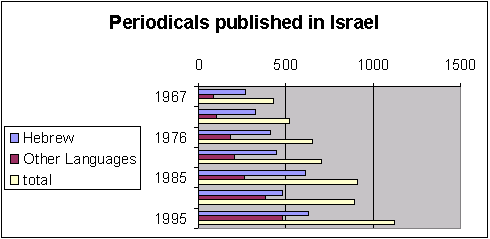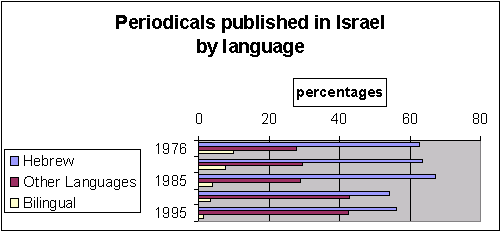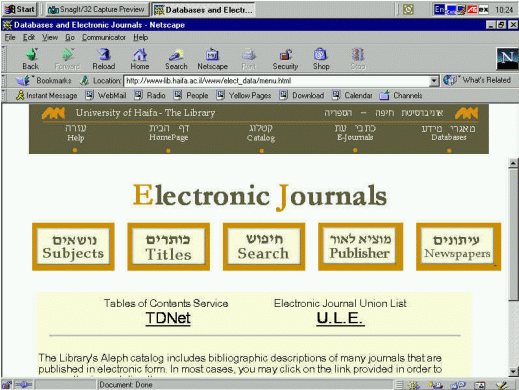 66th IFLA Council and General
Conference
Jerusalem, Israel, 13-18 August
Code Number: 085-144-E
Division Number: V
Professional Group: Serial Publications
Joint Meeting with: -
Meeting Number: 144
Simultaneous Interpretation: No
Aspects of serials management in Israeli academic libraries
Jair de Marcas
University of Haifa Library, University of Haifa
Haifa, Israel.
E-mail: dyair@univ.haifa.ac.il
Abstract
This paper describes management of Hebrew and non Hebrew language periodicals in Israeli academic Libraries. The Israel Union List of Serials is highlighted and the Israeli approach to electronic journal management is discussed.
Paper
Introduction
This paper outlines several aspects of serials management in Israel in academic libraries. It also analyzes at some length Hebrew language serials, management of the Hebrew language serials collection and retrieval of articles in Hebrew. Non-Hebrew language serials in Israeli University Libraries are mentioned and the cataloging of Serials in all languages. It also presents the Israel Union List of Serials. Here the active role of the Union List will be highlighted. The final part of this lecture will describe the Israeli approach to Electronic Journal management, including Hebrew language periodicals on the Internet and problems associated with Hebrew on the Internet.
Hebrew Language Serials
The first periodical in Hebrew appeared in Amsterdam in 1691. Since then, many Hebrew language periodicals have been published outside Israel. In Israel, then under Ottoman Empire rule, the first Hebrew periodical, HaLevanon, was published in 1863. The difference in subject matter between the Hebrew newspapers published in Palestine and outside Palestine is striking. The Palestine newspapers reported actual events, while Hebrew newspapers in the Diaspora wrote on educational subjects such as literature, linguistics, bible studies, and the sciences. The style of language is not the same. In the Diaspora, the newspapers used biblical Hebrew, while in Palestine, modern Hebrew was used and the newspapers took as such a active part in the development of modern Hebrew1.
Today the number of Hebrew language periodicals currently published in Israel is not exactly known. The Central Bureau of Statistics reports a much lower number of current Hebrew journals (629) than is reported by the catalogues of the University Libraries. The figures of the Central Bureau of Statistics rely on the catalogue of the National Library. Two copies of every periodical published in Israel must be deposited in the National Library by law. It is possible that not every periodical is indeed forwarded and therefore the exact number of periodicals published in Israel is not exactly known. For example, the number of active Hebrew periodicals registered in the catalogue of the University of Haifa Library is much higher and stands currently at about 900. The Israel Union List of Serials holds about 5700 journals current subscriptions. This seems too high and may reflect incorrect or missing reports of the participating libraries. Therefore it is assumed that over 1000 Hebrew periodicals are currently published in Israel.
The figures shown below rely on information provided by the Central Bureau of Statistics as it is the only source that provides continuous and systematic statistics of the changes in the number of periodicals that have appeared over the years.


(Source: Central Bureau of Statistics, Daily newspapers and periodicals published in Israel, 1995. p. X)
Non Hebrew Language Serials published in Israel
Although the total number of periodicals published in Israel has continually increased and stands at 1121 (as of 1995), the proportion of Hebrew language periodicals steadily decreased and constitutes to 56% of the total local output in 19952. Many of the new journals established in this period are published in English or Russian.
This can be attributed to a number of factors:
Demographic changes - During the 1990s, nearly a million people immigrated to Israel, mainly from the former Soviet Union3. The foundation of new newspapers and periodicals in the Russian language was in response to a growing demand. Also the kind of periodicals that were founded reflects the needs of the immigrant population. Most publications are of a general kind and inform on current events in the areas of politics, economics, culture etc.
Academic Trends - Most Israeli researchers prefer to publish in English. The results of their research are then accessible to a much wider audience. Additionally, Israeli Universities encourage their faculty to publish in non-Hebrew language journals. Although publications in Hebrew language journals are recognized, it is necessary for researchers to present their findings in non-Hebrew periodicals for reasons of tenure or promotion. English language serials published in Israel reflect this trend and usually present material from specialized fields.
Subject matter of Hebrew Language Serials in Israel
The subject matter of most Hebrew Periodicals is specialized. There are very few serials of general nature, and they usually are the daily national and weekly local newspapers.
Specialized Hebrew serials can be divided into several categories:

Source: Catalogue of the University of Haifa Library
As could be expected, a large number of Hebrew journals are in the field of Judaism (about 14%), but most journals are in the field of the Social Sciences and the Humanities (about 64%). Relatively few exact science journals are published in Hebrew and that can be attributed to the strong preference of exact science researchers to publish in English. The small proportion of general journals (about 3%) results from the fact that the University of Haifa Library does not collect general popular journals. However, the Library collects nearly all specialized journals published in Hebrew, which assists the maintenance of the Index to Hebrew Periodicals produced by the Library.
Management of Hebrew language periodicals
Hebrew language periodicals are published by hundreds of different institutions, government bodies, commercial publishers, political parties and foundations. In order to deal with this large number of suppliers, the University of Haifa Library decided to purchase through a local bookstore for the purpose of Hebrew language periodical acquisitions. This local bookstore was encouraged to supply the Library with all Hebrew language periodical publications it demanded and later started to supply other universities and institutions as well. The creation of a local vendor for Hebrew Periodicals formed one address for acquisition, claiming and payment. This enormously reduced the workload of the Serials Librarian.
However, there are quite a few Hebrew periodicals that are still supplied directly to the Library. These are mainly journals supplied without charge or journals that wish to be included in the Index to Hebrew Periodicals project. These still demand individual treatment and follow-up.
At the University of Haifa Library, the Hebrew Language Periodical collection is set apart from the non - Hebrew Periodical collection and managed like a "Reserves" collection. The reason for this decision is that undergraduate students use the collection intensively as they prefer reading Hebrew to other languages. Also, Hebrew language periodicals are frequently the only source for information on aspects of Israeli society, culture and current events. In addition, the collection is open to high school students and the general public. One is not allowed to take out items from the Hebrew Periodical Area and photocopying machines are placed near the collection.
Retrieval of articles in Hebrew Language Journals
The most common way to retrieve articles from Hebrew language journals is through the online Index to Hebrew Periodicals Project (in short IHP). This Index is maintained by the staff of the University of Haifa Library and covers Hebrew articles from 1977 and onwards. The Project currently indexes nearly 400 journals and its database contains more than 656,000 records from more than 650 journals. The Index has a comprehensive thesaurus of Hebrew indexing terms and is used by many other libraries and indexing projects as well. The Thesaurus contains over 80,000 subject entries using the standard broad/narrow/related term relationship and about the same amount of see references and scope notes.
The Index serves a wide and varied audience and all kinds of libraries such as school libraries, public libraries and academic libraries.
The IHP database is an accumulation of four separate indexing projects all using the same thesaurus:
- The Index to Hebrew Periodical (1977 - ongoing)
- The Eretz Israel Data Base - cooperative project with the Library of Yad Yitshak Ben Zvi
- The Tel-Hai Index to Hebrew Newspapers 1985-1997 (discontinued due to lack of funds)
- Bar Ilan Indexing Project - Indexes articles in the literary supplements of the daily Hebrew press (1985- ongoing).
Non-Hebrew language serials
Non-Hebrew language periodicals form the bulk of the Serials collections of the Academic Libraries in Israel. For example, the University of Haifa Periodicals collection houses over twenty thousand titles, but only about 14% of these are Hebrew Language serials.

(Source: Catalogue of the University of Haifa Library)
As in most academic libraries around the world, nearly all foreign language journals are acquired through local or international vendors. A very large slice of the acquisition budget of academic libraries goes to the Periodicals Department. Like academic libraries abroad, Israeli academic libraries also have difficulties in coping with the large increases in the prices of serials. An additional strain on the budget is the addition of electronic journals without being able or willing to cancel paper subscriptions. As a result, Israeli academic libraries are constantly reconsidering their current subscription and sometimes forced to cancel subscriptions as results of these budgetary constrains.
Serials cataloging and classification in Israeli academic libraries
All journals in Israeli academic libraries are cataloged in their OPAC's. However, they are not classified, but arranged on the shelf according to the alphabet. An exception to the rule is the University of Haifa Library. Here periodicals are classified using a system adapted from the Library of Congress. In addition, every journal receives subject headings according to LC. If there is no appropriate LC subject heading for a periodical, e.g. Israeli periodicals, a subject heading is modified.
Israel Union List of Serials
Israeli Union List of Serials (ULS) is maintained by the Jewish National and University Library in Jerusalem. The Union List contains the holdings of more than 170 Israeli libraries. These include the academic libraries, college libraries, government libraries and some special and public libraries as well.
The principle use of the ULS by the libraries is for Interlibrary Loan and Document Delivery purposes. By checking the ULS catalogue, it is easy to see which libraries own certain journals. The ULS database is also used for copy cataloging purposes. If a journal is not located in international databases (usually Israeli and Arabic journals), the ULS catalogue can be a useful source of information.
The ULS has more than 100,000 records and last year about 2,000 new records were added. The participating libraries do not add records themselves, but report to the staff of the ULS. The accounts are then edited by the ULS staff, added to the ULS catalogue and assigned an unique number. After the record has been added to the ULS database, individual libraries are able to edit changes in holdings themselves.
These reports to the Union List must include the ISSN number of the journal. Using the ISSN number, the unique ULS number is then automatically uploaded into the reporting institution's catalogue. By adding the ULS number to the library's catalogue, it is possible to update the library's records using the ULS database. Currently, it is most functional in updating local library records of jointly purchased electronic journals.
Electronic Journals in Israeli academic libraries
With the advent of electronic journals, every Israeli academic library has tried its own approach to manage this new resource. In 1998, the universities decided that it was more efficient and cheaper to cooperate and share resources. This lead to the creation of the Israel Center for Digital Information Services (Hebrew acronym MALMAD). Its purpose is to serve as a joint framework (consortium) for the acquisition, licensing and operation of information services to all the Israeli universities.
For the matter of electronic journals, the MALMAD succeeded in signing a number of contracts with leading publishers such as Academic Press, Springer, Kluwer and others. These contracts grant member institution IP number controlled access to the electronic versions of the journals. In addition to services funded directly from the MALMAD budget, it serves as a joint purchasing agent for services that interest several MALMAD members. In that case, joint purchase can bring significant discounts.
In order to enhance access to these electronic journals, the MALMAD decided to create the Union List of Electronic journals (ULE). This project centrally catalogs all electronic journals available to the MALMAD member libraries, creating both central listings and records that can be uploaded into local catalogs. These records are also added to the Union List of Serials and include links to full text as well as links from the Union List to the Web OPACS of member libraries4.
There are, of course, electronic journals that are not provided for within the MALMAD framework. These fall into three categories: 1. Purchases of electronic journals by individual universities outside the MALMAD framework; 2. Journals that can be accessed free of charge, providing one subscribes to the print edition. This usually means that the charge for online access is already calculated within the subscription price; 3. Databases such as Dialog that provide the full text of journals as well. At University of Haifa Library, we make a serious effort to catalogue all the journals and thus provide access to a wide range as journals as possible. Except for the considerable cataloging effort, a lot of time is spent on gaining access and working out the technical details.
Below are two examples of access points to electronic journals taken from the University of Haifa Catalogue. The first one shows access using the web module of the library OPAC.

The second shows an alternative way. The systematic cataloging of electronic journals in the Library's catalog makes it possible to automatically generate searchable lists. Alphabetic lists of electronic journals, by title and subject, are generated nightly, incorporating changes made in the catalog during the preceding day. Patrons may browse the lists or search for specific items, using a search engine that creates Web pages displaying the records retrieved from the Library catalog.

We can see that the catalogues of Israeli university libraries are the central tool for accessing all kinds of Library resources, print and digital alike, thus creating a true hybrid library environment.
Hebrew journals on the Internet
Access to full text Hebrew periodicals on the Internet is considerably behind that of English journals.
There are a number of reasons for this:
- The publishers are conservative and think that in this relatively small market, Hebrew Internet publishing will decrease profitability, especially in the face of the costs involved to create online data vis-à-vis the expected profits.
- Technical problems. Like other non - Latin scripts, presenting Hebrew on the web is problematic. Moreover, two different ways to present Hebrew were developed, one adapted to Netscape browsers and one for Microsoft browsers. Also special fonts have to be installed on the computer to read Internet Hebrew. Printing out Hebrew text from web pages presents more problems to the user, often producing illegible pages.
Therefore, it will not come as a surprise that an important push for the development of Hebrew journals on the Web came from the Universities and government institutions. One of the first to develop and host the electronic version of Hebrew journals was the Hebrew University in Jerusalem with a project called Snunit - "The Center for the Advance of Web Based Learning"5. In addition, a number of official government publications are now available on the Internet in full text.
Commercial publishers do not yet present the complete digital issues of their paper journals on the Web. Many established a web presence, but present selected articles for advertisement purposes. Two daily newspapers are the exception and present same day news free of charge. Access to their digital archives is not gratis.
Conclusion
To sum up, the creation of the MALMAD consortium is an important development in the area of management of periodicals in Israeli Academic Libraries. For the first time, national cooperation was achieved in acquisition and cataloging of electronic periodicals. This opens the way for other cooperative efforts, which may eventually enrich the Israeli academic periodical collection. However important the joint effort is, one should not ignore or dismiss the specific needs of every institution participating in the MALMAD consortium.
End Notes
- Shochot, Anit, Periodicals in Israel: growth and changes over time; a bibliometric analysis 1950-1984, M.A. Thesis, Hebrew University of Jerusalem, 1986, pp.9-11.
- Central Bureau of Statistics, Daily newspapers and periodicals published in Israel, 1995, p.4.
- Central Bureau of Statistics, Statistical abstract of Israel, 1999, chapter 5.
- Adler, Elhanan, University library cooperation in Israel: The MALMAD consortium, Information Technology and Libraries, 18 (3), 1999, 135-138.
- Snunit - URL:http://www1.snunit.k12.il/English/.index.html.
|






